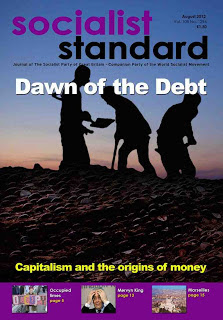According to Stuart Jeffries in the Guardian (5 July), “Marxism is on the rise again”. One of the reasons he gives for this is “its analysis of economic crises”. But what is this analysis?
The problem with trying to describe Marx’s own theory is that he never published a final, worked-out version. In Volume 1 of Capital there are some passing references to capitalist production going in cycles “of average activity, production at high pressure, crisis and stagnation”. Apart from that, all we have are drafts and notes on the subject which Engels, Kautsky and Moscow later published as Volumes 2 and 3 of Capital, Theories of Surplus Value and the Grundrisse, but these drafts are not always entirely consistent with each other.
This has led to a number of different Marxist theories. The explanation we have favoured is that crises are caused during the phase of “production at high pressure” by one key industry (it could be any). This industry, in its anarchic pursuit of profits, comes to overproduce in the market for its products, and this partial overproduction then has a knock-on effect on the rest of the economy.
Others interpret “overproduction”in a different sense, to mean that capitalism has a tendency for total capitalist production to outstrip total market demand. An example can be found in the January-February issue of Lalkar (a publication of the Communist Party of Great Britain (Marxist-Leninist), but it’s a theory put forward by others who don’t share this party’s policy). The present crisis, it claims:
“is at heart a classic crisis of overproduction, this being the design fault that is built into the capitalist system. As the masses of workers –who make up the bulk of consumers –are, in the interests of profit, paid as little as possible, they are increasingly unable to buy all the increasing mass of commodities that the capitalist enterprises bring to market. This in turn bankrupts the least ‘efficient’ of the capitalist enterprises, causing further job losses and downward pressure on wages caused by an excess of the supply of labour power over the demand for the same. Bankruptcies start to escalate, while economic activity stagnates.”
This is a theory of “underconsumption” rather than of “overproduction”. It ignores the fact that the total capitalist market is not made up just of what workers can afford to buy, not even if capitalist spending on consumer luxuries is added; it also includes what capitalist enterprises re-invest in production, i.e. spend on producer goods.
Lalkar offers the following explanation as to why the present crisis didn’t break out earlier:
“However, this process can be, and is, retarded by the simple expedient of the capitalists, who would otherwise find it difficult in the circumstances to invest profitably, lending money to workers to enable them to continue as consumers despite their relative poverty.”
This doesn’t make sense. The capitalist class lend the working class money to buy their goods, but how would they make a profit out of doing this? They would only get their money back.
Working-class borrowing did increase in the period up to the present crisis but this wasn’t done deliberately to prevent production spiralling downwards. It was the other way round: because production was expanding, banks and other lenders made loans to workers on the assumption that production would continue to expand and so workers would be able to repay out of their future wages both what they had borrowed and the added interest.
A crisis is not caused by working-class consumption going down but by capitalists cutting back their investment in production. It is investment, not consumption, that drives the capitalist economy. This is the essence of Marx’s theory of capitalism, whatever might have been his considered theory of crises had he got round to formulating it.

No comments:
Post a Comment